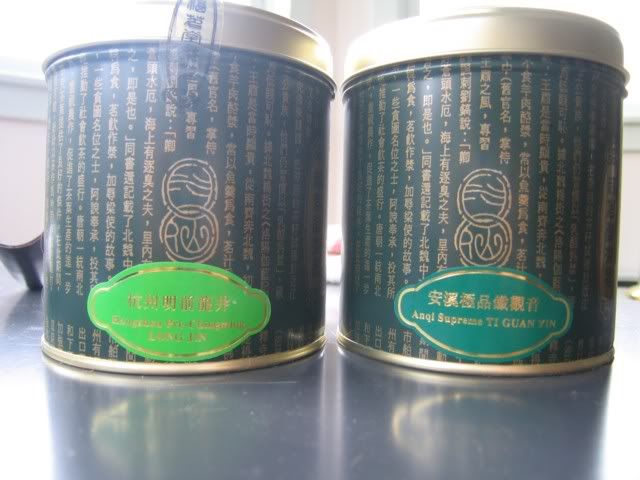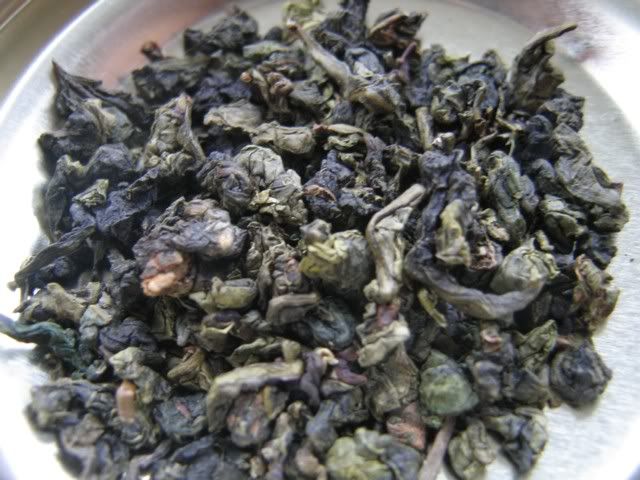I’m so caffeine buzzed. Greedy me.
I didn’t have time to drink any tea until around 8pm today after dinner. Since I’ve been drinking qingxiang tieguanyin the past few days (well, not counting the take-out tea days) I felt I needed a change, so I went to nongxiang tieguanyin instead. Yes, a big jump.
I have lots of this stuff of various stripes. Specifically, I have three kinds of this stuff, but I have a substantial amount of each of them, which is bad news. I can’t clear it fast enough. Anyway, so I decided to open up a new pack of it, since the only one that’s open right now is the Athelier stuff which I’ve talked about a while ago. This time, what I’m opening is from Kung Fung Yung. They are a teastore in Taipei, tucked away in a street that’s really not very busy most days. My girlfriend somehow found this place when she was there two years ago, and brought some gifts back. I went with her last summer when I was there, and also brought some stuff back.
When the website does work, you will see that it is easily the nicest website of all the Chinese teastores in the world, at least among all the ones I’ve seen. A number of mainland ones will tell you they have a website, but the links are often dead or content nonexistent. The Hong Kong ones generally are also fairly poor (I think some people buy from Grand Tea). The only ones with good website are American ones, but the tea on offer is often pretty poor. So this store’s website is a nice change of pace as it doesn’t cater to the American audience yet has a functional and nice website. They also have nice packaging, which makes for great gifts. But what about their teas?
Since they’re a Taiwan firm, they sell mostly oolongs, although there is a sizable selection of puerh cakes as well when I went, mostly raw stuff that they repackaged. Quality at the store are generally fairly good, although variety is a little lacking compared to the Hong Kong ones. Prices are also not cheap, as one would expect given the way the goods look.
The tea I opened today is a tieguanyin that is fired and aged, which gives it a very brown hue and a heavier flavour. They are often refired every year or so during the aging process, and it doesn’t age like puerh where you can just leave it out and let it sit. When I brought some to my Hong Kong teashops, one guy, commonly referred to as Big Brother Hong, panned the tea. I don’t think it is quite as bad as he says it is, and since he has a vested interest (he’s one of the guys in charge of firing teas at the place) I honestly don’t know how much I should listen to him.
I used my nongxiang tieguanyin pot to brew this stuff today. It’s a very small pot that makes about two small cups. I filled about 1/2 of the pot with leaves, and brewed normally. One thing you notice about this tea is that fragrance is high. I think it caters to Taiwanese taste that way, and in fact, I have some suspicions that it might actually be a tieguanyin from Taiwan, rather than Fujian, which makes it an inferior grade. The reason I say this is because the body of the tea is thin, and while there is a high fragrance, the aftertaste is a bit lacking. Smells great, tastes wonderful the first few brews, but it falls after about the 4th/5th infusion. Depending on how you make it, there could be a hint of sourness in the back, but I think I controlled it pretty well today to avoid it and rather enjoyed the tea.
But then…. I felt it wasn’t enough. Perhaps I was caffeine starved all day, and perhaps the pot is a little smaller than usual, I wanted more. So I waited half an hour, and then brewed the Athelier stuff in a small gaiwan (makes one cup, it’s tiny). The Athelier stuff may actually be a little more fired than the Kung Fung Yung tieguanyin, and I think this is from Fujian, although they probably preserved it less well and some of the flavours have escaped. There is, unfortuantely, a distinct harshness about this tea when drunk immediately after the Kung Fung Yung, and the differences are obvious. There’s a bit of sourness, and the fragrance is not nearly as good. The aftertaste and body is slightly superior, perhaps, to the Kung Fung Yung, it is not nearly enough to make up for the difference in taste. If you have it on its own, it’s not bad. Having it together with something else, however, and it doesn’t compare so well. The fact that I used a gaiwan may have also made a difference. I might try it again with the teapot another day.
I might try the new stuff I got from Beijing that is also a nongxiang tieguanyin on a different day, but right now, I’m too buzzed to do anything.



 RSS - Posts
RSS - Posts
I took you at your suggestion and have been reading some of your old post-Covid posts. I haven’t been to…